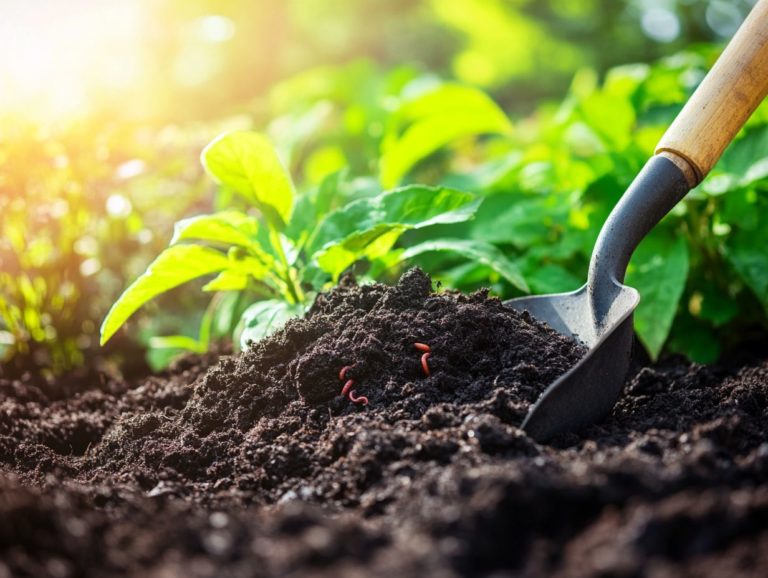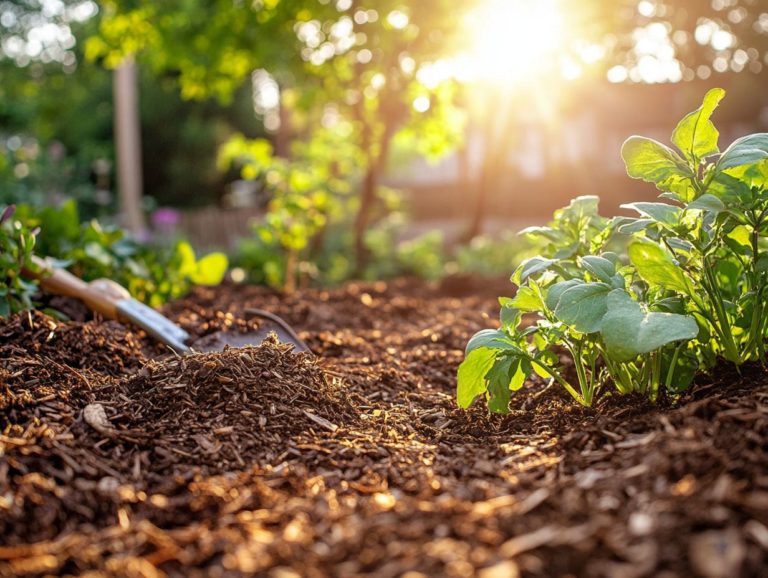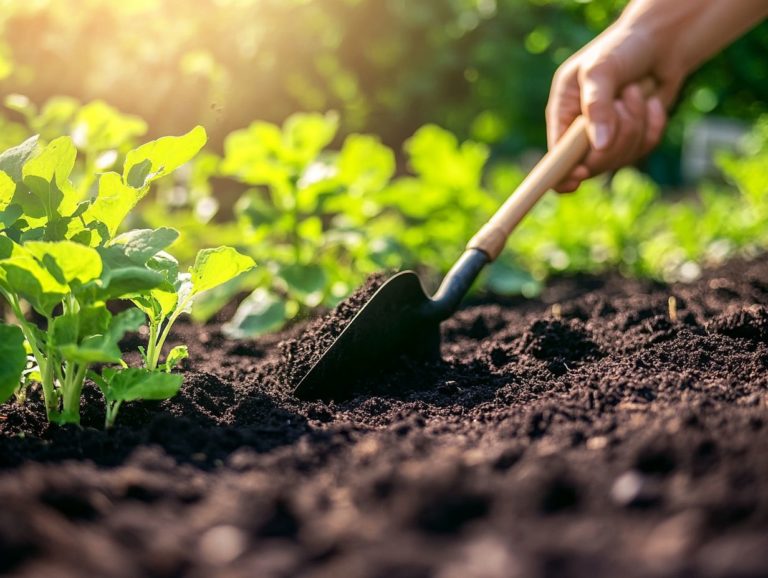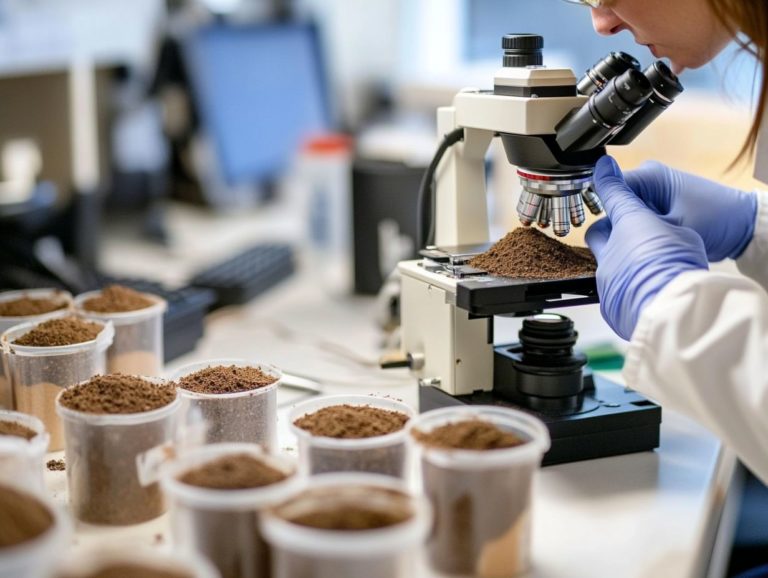The Benefits of Crop Rotation for Soil Health
Crop rotation is a time-tested agricultural practice that offers numerous benefits for soil health and farm sustainability. By regularly changing different crops in a given area, you will improve nutrient balance, reduce soil erosion, and naturally control pests and diseases.
This article will delve into the definition and purpose of crop rotation, a practice that promotes agricultural sustainability, highlighting its advantages for maintaining soil vitality. You ll find practical steps for implementation, potential challenges to consider, and inspiring success stories from those who have harnessed its power. Let s explore how!
Take a deep dive into the world of crop rotation and discover how it can transform your farming practices while promoting a healthier ecosystem.
Contents
- Key Takeaways:
- What is Crop Rotation?
- Benefits of Crop Rotation for Soil Health
- How to Implement Crop Rotation
- Challenges and Considerations
- Success Stories and Case Studies
- Frequently Asked Questions
- What is crop rotation and how does it benefit soil health?
- What are some specific benefits of crop rotation for soil health and agricultural sustainability?
- How does crop rotation help prevent soil erosion?
- What are the long-term effects of crop rotation on soil health?
- Can crop rotation benefit organic farming?
- What are some common crops used in crop rotation for soil health?
Key Takeaways:

- Crop rotation means planting different crops in a planned order to improve soil health and crop yield.
- This method helps maintain balanced nutrient levels in the soil, reduces erosion, and naturally controls pests and diseases, resulting in healthier and more productive crops.
- Proper planning and consideration of specific crop rotation patterns are essential for successful implementation, and drawbacks can be managed through careful management and adaptation.
What is Crop Rotation?
Crop rotation stands as a cornerstone of effective agricultural practice, where you regularly plant different crops in the same area across successive seasons. This approach not only enhances soil health but also maintains nutrient levels, promoting sustainable agriculture by preventing soil compaction and erosion.
By rotating a variety of crops, including legumes, corn, wheat, and beans, you can significantly improve soil structure and increase crop profitability, all while reducing the need for chemical fertilizers. Implementing well-thought-out crop rotation cycles yields greater harvests and delivers ecological advantages, making it an essential strategy in contemporary farming.
Definition and Purpose
The concept of crop rotation involves the strategic practice of alternating the types of crops cultivated on a specific piece of land, all aimed at enhancing various aspects of farming and soil health.
This technique greatly improves soil nutrients, thanks to the diverse root systems and organic matter left behind by different plants. It also plays a crucial role in breaking the life cycles of pests and diseases that thrive in growing the same crop repeatedly.
By diversifying your crops, you can significantly reduce your reliance on chemical fertilizers and pesticides, which is vital for promoting long-term agricultural sustainability.
Incorporating additional farming techniques, such as cover cropping and intercropping, can enrich your soil even further, restore balance to nutrient levels, and enhance your ecosystem’s resilience. This approach leads to healthier crops and a sustainable farming future.
Benefits of Crop Rotation for Soil Health
The advantages of crop rotation for soil health are numerous and intricate, including the benefits of intercropping for soil health, impacting nutrient levels, enhancing pest control, and promoting the retention of organic matter within the soil ecosystem.
Improved Nutrient Balance
Improving the nutrient balance in your soil is a significant advantage of implementing diverse crop rotation cycles. This approach not only facilitates better nutrient absorption but also minimizes the depletion of essential soil nutrients.
By incorporating crops with varying root systems into your rotation, you can enhance soil structure and tap into different nutrient layers. Deep-rooted plants, for instance, have the remarkable ability to draw up vital minerals from deeper soil zones while also creating channels that allow water and air to penetrate more effectively. This natural aeration boosts microbial activity, further enhancing soil fertility.
Alternating between legumes and other crops ensures continuous nutrient replenishment. Such strategic planning enriches your soil and can also lead to significantly higher agricultural yields, fostering sustainability and resilience in your farming practices.
Reduced Soil Erosion

Reduced soil erosion is a key benefit of crop rotation. It not only enhances your land management practices but also contributes to the benefits of crop rotation in pest control while preserving that precious topsoil.
This sustainable agricultural approach is vital for maintaining soil integrity in different ways. By rotating diverse crops, you leverage their unique root systems to form a robust network that binds the soil. This effectively prevents soil particles from being dislodged during heavy rains or strong winds.
Additionally, incorporating crop residues from harvested plants creates a protective layer over the soil surface. This layer acts as a shield against the erosive force of raindrops.
These residues help prevent surface runoff and contribute to improved soil structure by boosting organic matter content. In turn, this fosters a healthier ecosystem for your future crops, ensuring that your land remains productive and sustainable.
Natural Pest and Disease Control
Another major benefit of crop rotation is its ability to naturally manage pests and diseases. It disrupts the life cycles of pests and reduces the prevalence of diseases in your crops.
By alternating the types of crops you grow in a specific area, you can create an environment that discourages harmful insects and pathogens from thriving. For example, in regions where corn is regularly rotated with soybeans, you can effectively minimize the presence of pests that specifically target corn.
This method has shown remarkable results in the Midwest United States. Diverse planting not only aids in pest control but also contributes to improved soil health and increased crop yields.
You can also use companion planting techniques, where you grow crops that repel certain pests alongside susceptible plants. This enhances the effectiveness of these strategies, creating a balanced ecosystem that benefits both you as a farmer and the environment as a whole.
How to Implement Crop Rotation
Implementing effective crop rotation requires a thoughtful approach to crop planning. You’ll want to establish rotational systems that align with your specific farming techniques and the unique conditions of your locale.
This strategic alignment ensures not only optimal yields but also enhances soil health and sustainability in your agricultural practices.
Start planning your crop rotation today for a healthier farm tomorrow!
Planning and Rotational Patterns
Effective planning and rotational patterns are essential for your crop rotation success. They guide you in selecting the right crops and timing their growth cycles perfectly.
By carefully considering which crops thrive together, you can enhance soil health and boost your yields over time. For example, incorporating legumes into your rotation helps the soil hold onto nutrients that plants need, making it more fertile for the crops that follow.
Successful crop rotation strategies, like the three-field system or a straightforward two-crop rotation, show how alternating between deep-rooted and shallow-rooted plants optimizes nutrient uptake while minimizing pest pressure.
Embracing best practices, such as maintaining a diverse range of crop varieties, will further strengthen ecosystem resilience and elevate overall farm productivity.
Challenges and Considerations
While crop rotation offers many benefits, it also presents challenges and potential drawbacks that you must navigate to optimize your practices and maximize your yields.
Potential Drawbacks and Solutions

The potential drawbacks of crop rotation, when compared to monoculture practices, can indeed affect your farming efficiency and crop profitability in certain scenarios.
For example, you might notice reduced yields for specific crops that are particularly sensitive to frequent rotation. Constantly switching crops can lead to an imbalance in soil nutrients, ultimately compromising the health of your entire crop.
However, there are various strategies available to overcome these challenges. Implementing cover cropping can effectively restore nutrient levels and enhance soil structure. Additionally, using precision agriculture techniques allows you to tailor your planting and fertilizer application to the unique needs of each crop, ensuring optimal yields while promoting sustainability.
Success Stories and Case Studies
Success stories and case studies vividly demonstrate the profound impact of crop rotation on farming practices. See how agricultural producers enhanced their yields and sustainability by embracing this effective method!
Real-life Examples of Crop Rotation’s Impact
Real-life examples illustrate how you can effectively implement sustainable practices that enhance both soil health and crop yields.
Take, for instance, a farmer in Iowa who shifted from annual corn planting to a rotation with soybeans and oats. This shift reduced pest populations and led to an impressive 15% increase in overall yield within just two years!
Meanwhile, consider a tomato grower in California who integrated cover crops into their rotation. This approach significantly boosted soil moisture retention and reduced irrigation costs. During a particularly dry season, they saved nearly $2,000 on water expenses, showcasing the financial viability of such methods.
These farmers testimonials show that crop rotation promotes biodiversity and strengthens resilience against climate fluctuations.
Frequently Asked Questions
What is crop rotation and how does it benefit soil health?
Crop rotation is the practice of growing different crops in the same area over several years. This method improves soil health by replenishing nutrients, controlling pests and diseases, and preventing soil erosion.
What are some specific benefits of crop rotation for soil health and agricultural sustainability?

Crop rotation helps break up hard soil, allowing better root growth and water absorption. It increases soil biodiversity, improves soil structure, and reduces the need for chemical fertilizers and pesticides.
How does crop rotation help prevent soil erosion?
Planting different crops with various root structures and planting times maintains soil cover throughout the year, preventing erosion from wind and water. This also helps retain moisture in the soil, reducing the risk of drought.
What are the long-term effects of crop rotation on soil health?
Crop rotation builds and maintains healthy soil over time. It replenishes nutrients, prevents depletion, and promotes beneficial microorganisms, leading to higher crop yields and better overall soil quality.
Can crop rotation benefit organic farming?
Absolutely! Crop rotation is a key practice in organic farming as it helps maintain soil fertility naturally, reducing the need for external inputs. It promotes a balanced ecosystem and sustainable agriculture.
What are some common crops used in crop rotation for soil health?
Common crops include legumes, which fix nitrogen in the soil, as well as grains, root vegetables, and cover crops like clover and rye. The specific crops depend on climate, soil type, and farming goals.






